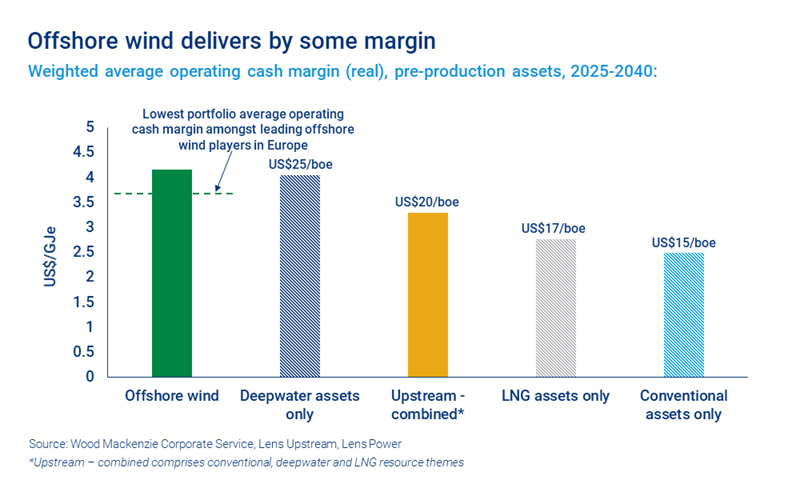与我们分析师联系
Big Oil set to cash in on the trillion-dollar offshore wind prize
A new metric shows how offshore wind can come up trumps on cash margins for the Majors
3 minute read
Akif Chaudhry
Research Director, Corporate Strategy and Analytics

Akif Chaudhry
Research Director, Corporate Strategy and Analytics
Akif focuses on strategy, benchmarking and valuation analysis related to power and renewables within company portfolios.
Latest articles by Akif
-
The Edge
Renewable developers change tack
-
Opinion
Elevated subsidies enable offshore wind to end 2023 on a high note
-
Featured
Mixed signals for power and renewables in 2023
-
Opinion
Big Oil set to cash in on the trillion-dollar offshore wind prize
-
Featured
Power and renewables companies face merging headwinds in 2022 | 2022 Outlook
-
Opinion
Natural gas: friend or foe in Europe’s 2030 emissions target?
No longer in its infancy, offshore wind is a proven technology on course to play a key role in the decarbonisation of the global economy. Over the next decade, the industry will attract almost US$1 trillion in new investment.
A growing number of competitors are flocking to take advantage of the massive opportunities that will be created by the boom. The Majors – notably the European Majors – are no exception. Right now, their share of the market is small, but ambition is ramping up as they bet bigger with their investments in the zero-carbon value chain. And there is all to play for as the offshore wind industry scales rapidly and globally.
Our insight Why the Majors need to consider margins in weighing up offshore wind uses a proprietary new metric to break down why offshore wind offers a big prize for Big Oil. Using the expertise of our Corporate Service, we provide a detailed analysis of the relative performance of new field assets across the oil and gas industry and compare that to offshore wind.
Visit the store to purchase the full report – or read on to learn why the renewable energy can be a vital cash flow generator as companies wind down their oil and gas portfolios.
Offshore wind delivers by some margin
Offshore wind will deliver higher unit operating cash margins than the Majors’ new field upstream portfolios.

Akif Chaudhry
Research Director, Corporate Strategy and Analytics
Akif focuses on strategy, benchmarking and valuation analysis related to power and renewables within company portfolios.
Latest articles by Akif
-
The Edge
Renewable developers change tack
-
Opinion
Elevated subsidies enable offshore wind to end 2023 on a high note
-
Featured
Mixed signals for power and renewables in 2023
-
Opinion
Big Oil set to cash in on the trillion-dollar offshore wind prize
-
Featured
Power and renewables companies face merging headwinds in 2022 | 2022 Outlook
-
Opinion
Natural gas: friend or foe in Europe’s 2030 emissions target?
The upstream sector has long analysed cash margins on a per barrel of oil equivalent (boe) basis. This well-understood metric reveals how much operating cashflow upstream oil and gas assets generate per unit of production. It’s especially useful for articulating cash generation capacity and benchmarking portfolios.
Conventional analysis of renewables pitted against oil and gas investment usually focuses on relative risk and returns. But comparison with the legacy business needs new metrics. Our new cash margin metric – operating cash flow per gigajoule equivalent (GJe) – goes beyond traditional comparisons. And it reveals that offshore wind comes up trumps.
Drawing on composite data from our Lens Upstream and Lens Power platforms, our study shows how a group of renewable leaders’ offshore wind portfolios stack up against the Majors’ oil and gas portfolios on this key metric. Tracking this asset-by-asset data demonstrates that offshore wind will deliver 25% higher unit operating cash margins in comparison to new field oil and gas projects.
Even the lowest offshore wind portfolio average operating cash margin is above the upstream average. And the renewable technology’s margins trump deepwater – Big Oil’s highest margin asset class.
Offshore wind’s strong operating cash margin performance shows that the financial prize is more than simply long-term and steady cash flows. Such a cash wedge within a business is a good way to support other portfolio areas or, indeed, a significant dividend commitment, and to hedge exposure to carbon and hydrocarbon prices.
Returns do, of course, matter. Falling IRRs from offshore wind projects will not be sustainable if the sector is to attract the capital required for it to play its part in meeting global climate goals. Mid-single digit returns will not be acceptable.
Companies have already been leaning on traditional tools of debt-financing and asset rotation to lift IRRs. As the sector matures other levers, such as increasing merchant exposure, power trading and building power-to-x projects, will also come in to play to boost returns.
As the bidders flock in, competition is increasing. To learn more about the shift in competitive dynamics and what it will take to succeed, read Sea change: navigating the trillion-dollar offshore wind opportunity.
The Majors can play the long game with offshore wind
Offshore wind is not without challenges: dark clouds of supply-led cost inflation and rising cost of debt are looming large. The industry is currently grappling with oversupply, while the demands of next generation technology mean that massive investment will be needed to back new tower production facilities.
But after years of managing volatility in oil and gas, the Majors are equipped to get the balance between risk and return right. And they are flush with deep pockets of cash to take advantage of the huge upcoming opportunities.
For a closer look at the analysis, head to the store for the full insight. Charts include:
- The weighted average upstream operating cash margins for the Majors’ current portfolios plotted against offshore wind
- New project nominal returns for the Majors’ upstream portfolios versus unlevered offshore wind projects, and
- Capital intensity in offshore wind tracked against upstream assets.







